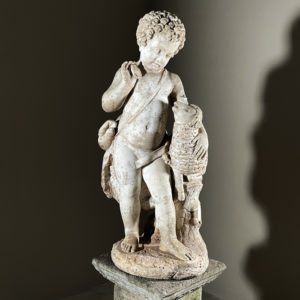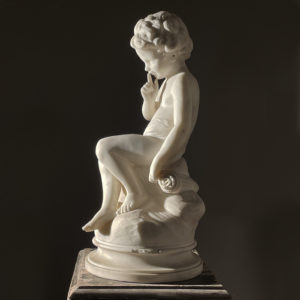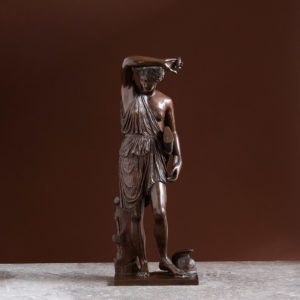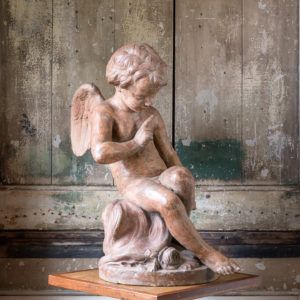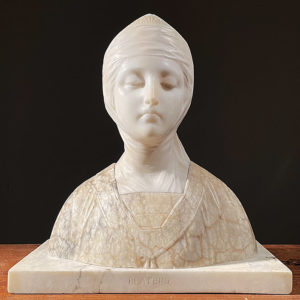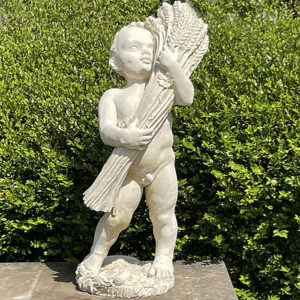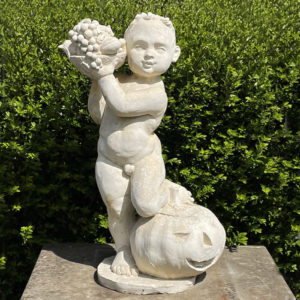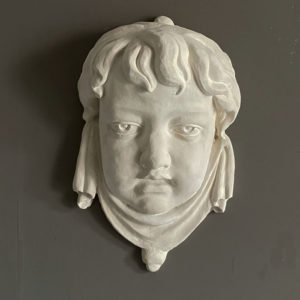147 items found
Page 1 of 2
-
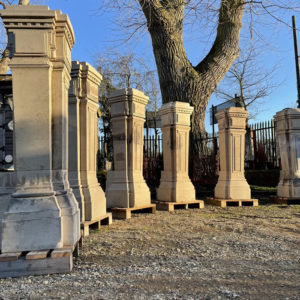
A set of six monumental Edwardian Portland stone sculpture pedestals
£60,000A set of six monumental Edwardian Portland stone sculpture pedestals
each square-section tapered pedestal with inset corners, attached to the wall at the foot-block, and each faced with a rectangular tablet with dentil and guttae mouldings above a panelled pilaster stem,£60,000 -
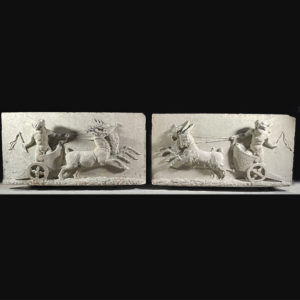
The Tehidy Plaques: a pair of George II carved limestone and lead relief-carved plaques
POAThe Tehidy Plaques: a pair of George II carved limestone and lead relief-carved plaques
each plaque, slightly coved in plan, carved in deep relief with a winged putto driving a chariot, on one tablet the chariot drawn by a pair of galloping stags (with original lead antlers), on the other goats; each putto raises a whip as they career towards each other,POA -
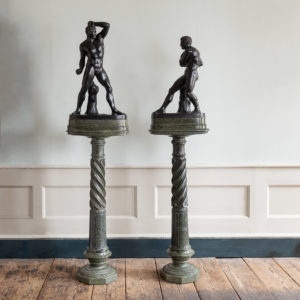
Mid-nineteenth century Italian bronze sculptures of Creugas and Damoxenes
£15,000Mid-nineteenth century Italian bronze sculptures of Creugas and Damoxenes
set atop serpentine columns. Creugante: Height 70.5 cm Width 42 cm Depth 18.5 cm Damosseno: Height 60 cm Width 39 cm Depth 18 cm Plinth: Height 119 cm Width: 44 cm Depth: 23.5 cm£15,000 -
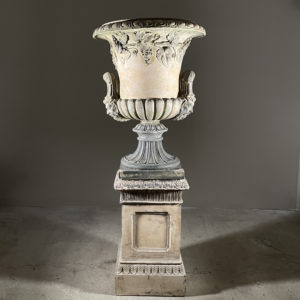
A very large late Victorian stoneware campana urn
£14,250A very large late Victorian stoneware campana urn
the semi-lobed campana urn with loop and elven mask handles and vine-leaf tendrils modelled in relief under the spreading rim, raised on a socle foot, above a square section pedestal, bearing the maker's mark "Doulton Lambeth" to each element,£14,250 -
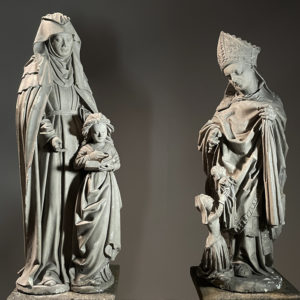
A pair of Victorian plaster statues
£11,000A pair of Victorian plaster statues
one, a group of St Anne teaching the Virgin Mary to read - the standing pair, in robed attire, looking down into the pages of a book, the mother tenderly supporting her young daughter as she reads; the other, the figure of St Augustine with bishop’s mitre and robes - clutching a drape and administering the sacrament to diminutive supplicants£11,000 -
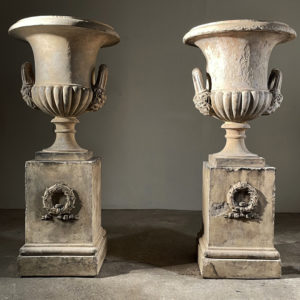
A pair of early Victorian stoneware garden urns
£10,400A pair of early Victorian stoneware garden urns
each semi-lobed campana urn with loop and mask handles and raised on a socle foot, above a square section pedestal with a relief-cast wreath to one side, bearing the maker's mark to each element,£10,400 -
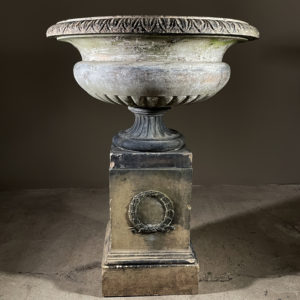
An Impressive mid-Victorian stoneware garden urn
£8,900An Impressive mid-Victorian stoneware garden urn
the bulbous tazza with an everted rim raised on a socle foot, above a square section pedestal with a relief-cast wreath to each side, bearing the maker's mark to each element,£8,900 -
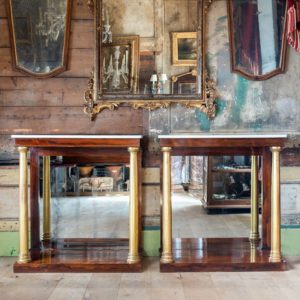
Pair of Regency rosewood pier tables,
£8,500Pair of Regency rosewood pier tables,
with statuary marble tops supported by gilt Tuscan columns, with pilasters to the rear flanking mirrored backs, on plinth bases.£8,500 -

An early Victorian Devonian marble chimneypiece
£5,750An early Victorian Devonian marble chimneypiece
the rectangular shelf with bead mould over cushion mould jambs and frieze united by step and facet cut end-blocks, all raised on square foot-blocks, restorations,£5,750 -
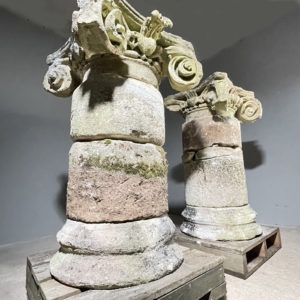
A pair of English carved limestone Ionic order capitals with associated columnar stem-sections and feet
£5,600A pair of English carved limestone Ionic order capitals with associated columnar stem-sections and feet
each with a Roman Ionic order capital, with spirally carved volutes, raised on cylindrical "drums" from the stem and a torus moulded foot, heavily weathered£5,600 -
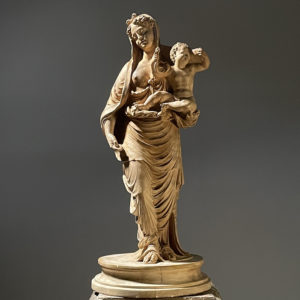
“Charity” a Victorian plaster cast of one of the marble Virtues intended for the early 16th Century tomb of Gaston de Foix
£5,600“Charity” a Victorian plaster cast of one of the marble Virtues intended for the early 16th Century tomb of Gaston de Foix
the classically dressed standing figure with a veiled head, sandalled feet, and her right breast bared, carrying an infant who grasps the veil and turns away, a coin proffered from her right hand, raised on a torus plinth,£5,600 -
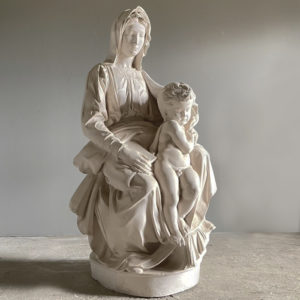
“The Bruges Madonna”, a full-size painted plaster Madonna and Child group
£4,980“The Bruges Madonna”, a full-size painted plaster Madonna and Child group
the seated Virgin in ruched gowns supporting the naked young Christ child standing against her leg, a book in her lap, both raised on a circular plinth,£4,980 -
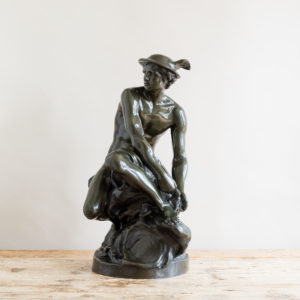
Large bronze model of a seated Mercury,
£4,850Large bronze model of a seated Mercury,
late nineteenth century or early twentieth century, French,base diameter 27 cm.£4,850 -
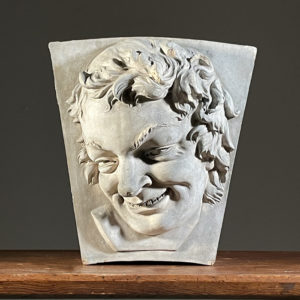
A wonderful example of a Georgian Coade stone keystone
£4,625A wonderful example of a Georgian Coade stone keystone
the lively relief portrait of a lascivious youth, grinning, emerging from the tapered keystone, the maker's mark hand-cut to the underside,£4,625 -
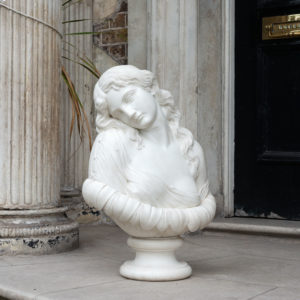
Nineteenth century statuary marble portrait bust of ‘Clytie’,
£4,500Nineteenth century statuary marble portrait bust of ‘Clytie’,
the female figure shown emerging from lotus leaves, on socle.£4,500 -
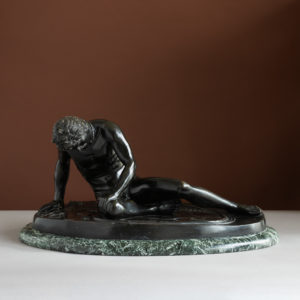
Bronze figure of the dying Gaul
£4,500 -
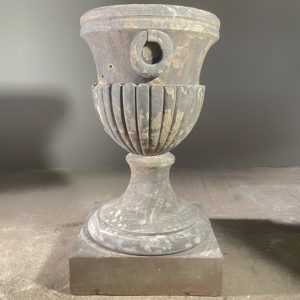
A substantial Victorian carved sandstone garden urn
£4,250A substantial Victorian carved sandstone garden urn
the semi-lobed vase body with moulded rim and carved ring handles to each side, roughly hewn within, raised on a generous socle foot and a square section plinth£4,250 -
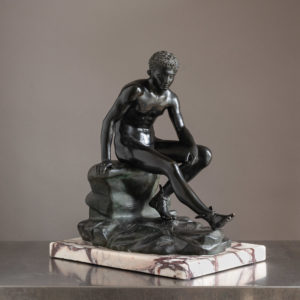
Nineteenth century Italian bronze model of Seated Hermes
£3,800Nineteenth century Italian bronze model of Seated Hermes
stamped 'GIORGIO SOMMER FOUNDRY, NAPLES', set on marble plinth base.£3,800 -
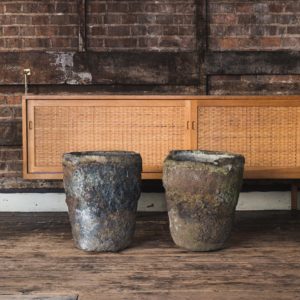
Exceptional pair of foundry crucibles,
£2,850Exceptional pair of foundry crucibles,
well patinated throughout, previously drilled for used as planters.£2,850 -
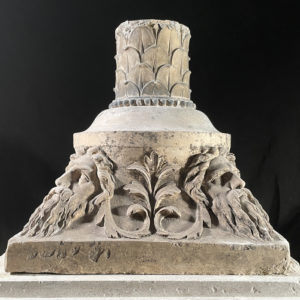
A rare mid Victorian stoneware pedestal
£2,400A rare mid Victorian stoneware pedestal
the columnar stem, cast with stiff-leaf ornament above the spreading square section base ornamented to each corner with a bearded mask, with a leafy plant centring each side, stamped: "J.M BLASHFIELD, MILLWALL AND PADDINGTON"£2,400 -
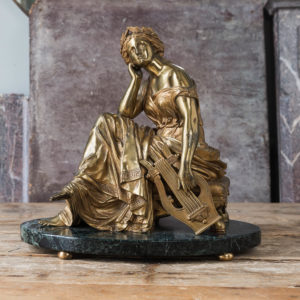
Nineteenth century gilt bronze model of Sappho,
£2,200Nineteenth century gilt bronze model of Sappho,
set atop Verde Antico marble base, with ball feet.£2,200 -
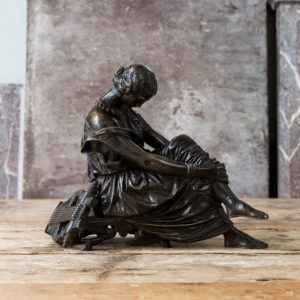
Nineteenth century French bronze of Sappho
£1,950 -
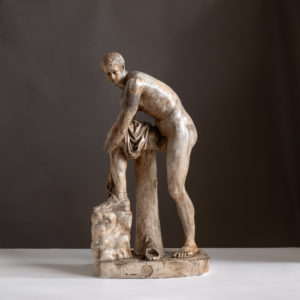
Plaster statue of Hermes fastening his sandle,
£1,850Plaster statue of Hermes fastening his sandle,
A French Mid-Nineteenth Century copy of the so called Sandal-binder Hermes. The Roman figure is held in the Musée du Louvre in Paris. The statue in the Louvre is a Roman marble copy of an original Greek Bronze by Lysippus. The appearance of the original, which stood in the Thermae of Zeuxippos in Constantinople, was described in detail by Christodoros of Koptos (491-518) : "There was Hermes ... He stood and fastened up the thongs of his winged sandal with his right hand, yearning to rush forth upon his course. His swift right leg was bent at the knee, and on it he rested his left hand, and meanwhile he was turning his face up to heaven, as if he were hearing the commands of his king and father" Three other complete copies of the Sandal-binder Hermes have been discovered or unearthed since Gavin Hamilton recovered the first complete antique figure from the swamp of the Pantello in 1749, thereby establishing it's identity firmly as Hermes and acknowledging it's status as one of the received masterpieces in the canon of antiquity. It appears to have been placed ornamentally in baths and gymnasia.£1,850 -
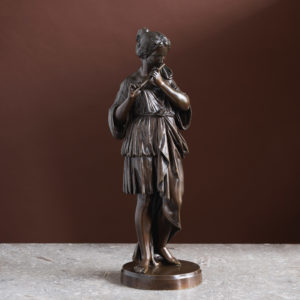
French Bronze of Euterpe
£1,850 -
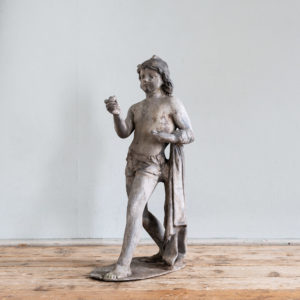
Lead statue of the Neopolitan Fisherboy
£1,850 -
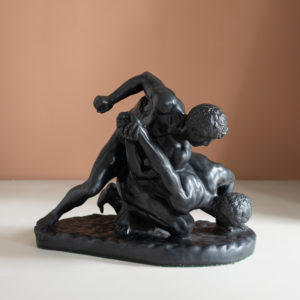
Nineteenth century bronzed plaster cast of ‘The Wrestlers’,
£1,800Nineteenth century bronzed plaster cast of ‘The Wrestlers’,
after the original by Antonio Canova£1,800 -
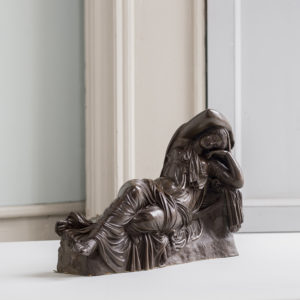
Nineteenth century French bronze of the Sleeping Ariadne
£1,650Nineteenth century French bronze of the Sleeping Ariadne
after the antique, the 'original' - itself a copy of an earlier Hellenistic sculpture - held in the Vatican Museums.£1,650 -
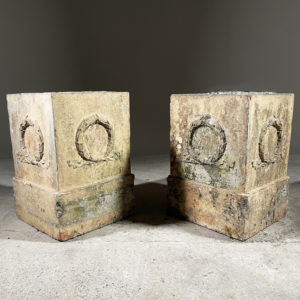
A pair of early Victorian stoneware garden pedestals
£1,600A pair of early Victorian stoneware garden pedestals
each rectangular plinth with a wreath cast to each side, each stamped with the makers mark£1,600 -
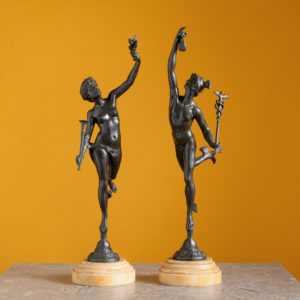
Pair of bronze statues Mercury and Fortuna,
£1,500 the pair -
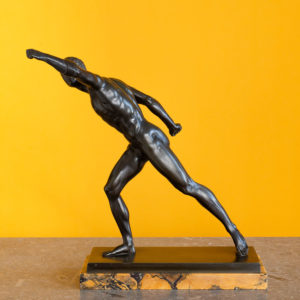
Nineteenth century bronze of the Borghese Gladiator
£1,500 -
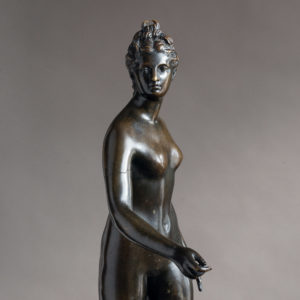
Bronze model of Diana the Huntress
£1,500Bronze model of Diana the Huntress
French c.1900, after the original by Jean-Antoine Houdon (1741-1828)£1,500 -
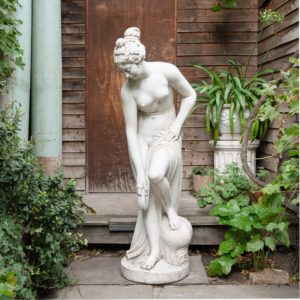
Large Italian figure of Venus after the Bath
£1,250Large Italian figure of Venus after the Bath
recently made in reconstituted marble, with surface wear and minor marks, suitable for exterior use.£1,250 -
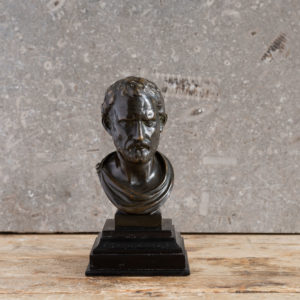
Italian bronze bust of Demosthenes
£1,250Italian bronze bust of Demosthenes
mid-nineteenth century Italian, the great Greek orator modelled wearing a tunic, on marble plinth base£1,250 -
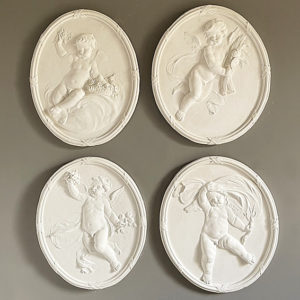
A set of four English relief-cast plaster ovals
£1,200 the setA set of four English relief-cast plaster ovals
each modelled with a winged putto bearing attributes for the seasons of the year,£1,200 the set -
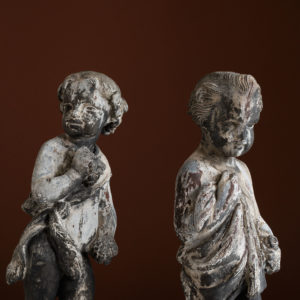
Pair of lead putti Summer and Autumn
£1,150Pair of lead putti Summer and Autumn
the pair of lead allegorical putti figures representing Summer and Autumn, Summer with flowers in its hand, Autumn with grapes. late nineteenth century Autumn is 66.5 cm high, Summer is 65 cm tall£1,150 -
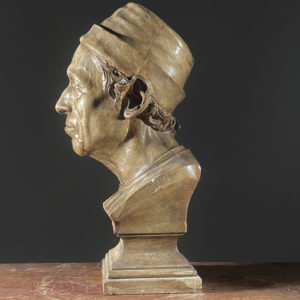
A Victorian plaster bust, purportedly of Girolamo Benvieni (1453-1542)
£1,150A Victorian plaster bust, purportedly of Girolamo Benvieni (1453-1542)
the characterful man, his curly hair protruding from his felt cap, raising his eyes a dextra, raised on a square section socle, old-shellac patina£1,150 -
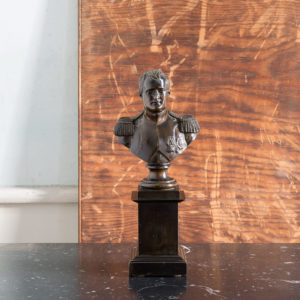
Nineteenth century bronze of Napoleon Bonaparte,
£1,000 -
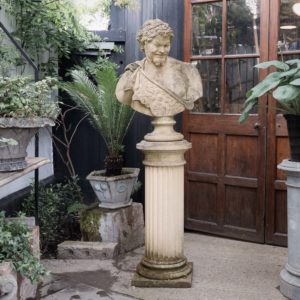
Reconstituted stone bust of Bacchus on pedestal,
£975 -
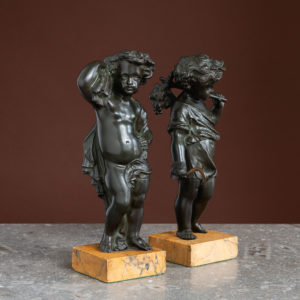
Pair of nineteenth century bronze figures of Harvest and Plenty,
£950 -
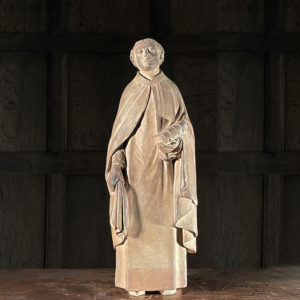
A charming terracotta figure of a monk
£945A charming terracotta figure of a monk
the standing male in habit and cloak, carrying a bible in one hand and grasping his robes in the other, his chin slightly raised and his eyes half-closed in a pensive mood,£945 -
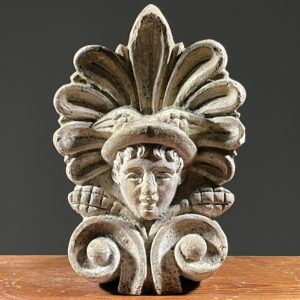
A small English neo-classical stoneware anthemion roof finial
£895A small English neo-classical stoneware anthemion roof finial
delicately modelled with a mask of Mercury, sporting his trademark winged cap, set within the splayed lobes of an anthemion, a pair of pineapple finials and an opposed pair of scrolls below, fragments of old paint,£895 -
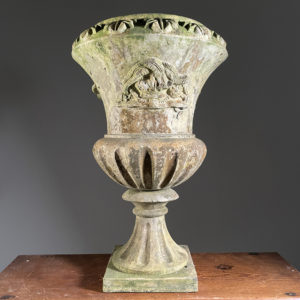
A Victorian stoneware garden urn
£875A Victorian stoneware garden urn
of semi-fluted campana form, the everted rim with stiff-leaf mouldings above the vase-shaped body bearing an applied motif of crown and ostrich feathers, raised on a fluted socle£875 -
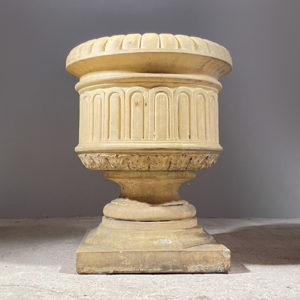
A late Victorian stoneware garden urn
£795 -
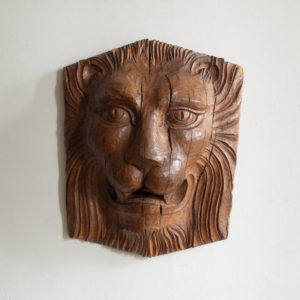
Large oak lion mask,
£775 -
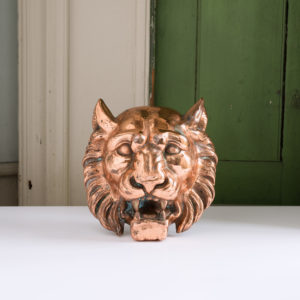
Large 1920s cast lion’s mask
£675 -
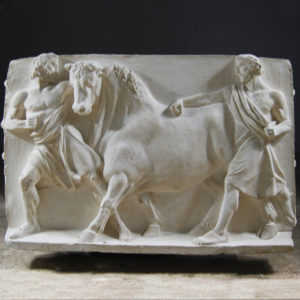
An English relief cast plaster plaque of men leading a bull
£640An English relief cast plaster plaque of men leading a bull
the rectangular panel, in the style of an antique metope,£640 -
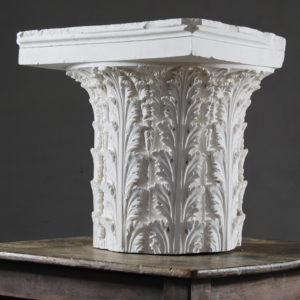
An English cast plaster Corinthian order pilaster capital,
£625An English cast plaster Corinthian order pilaster capital,
the capital, three-quarter round, intended for heading an "attached column", cast over-all with formalised stiff-leaf acanthine ornament spreading to a rectangular capping plinth, cast with wire hoops to the reverse for wall-hanging if preferred,£625 -
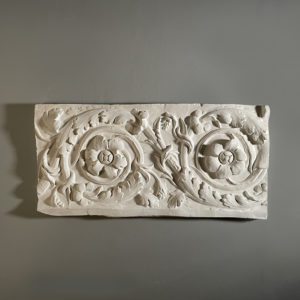
A cast plaster section of foliate scroll frieze
£560 -
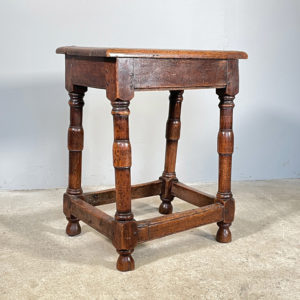
An English oak joint table stool
£550An English oak joint table stool
the radius moulded rectangular top raised on cylindrical legs, ring turned top and bottom, with inverted cup detail, united by a moulded box stretcher,£550 -
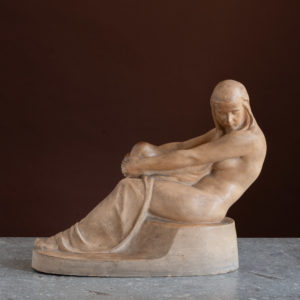
Art Deco Terracotta Mantle Figure of a Reclining Female.
£500Art Deco Terracotta Mantle Figure of a Reclining Female.
The patinated cast terracotta figure of a reclining female, head bowed, with one leg drawn towards her, and draped material over her legs. An indecipherable signature to base. Possible French.£500 -
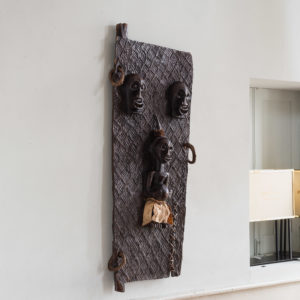
Congolese Songye door
£480 -
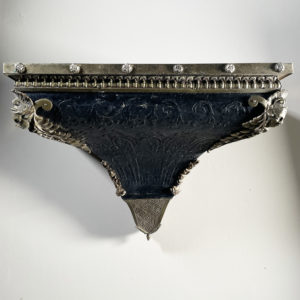
A Spanish wall-mounted bracket plinth
£445A Spanish wall-mounted bracket plinth
the rectangular wooden plinth with studded brass edge above the tapered ogee support clad in repousse Spanish leather with mask and foliate appliques and a pendant terminus£445 -
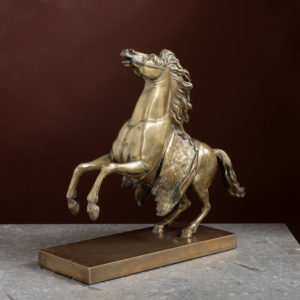
Brass model of a rearing horse,
£400 -
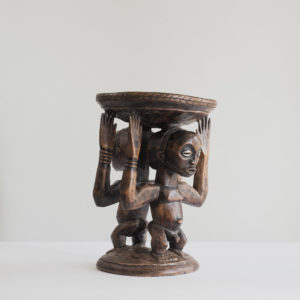
Luba female / male stool,
£375Luba female / male stool,
Luba art relates most commonly to the Kings and Chiefs of the Congolese Luba tribe, who would assert their power by display of ceremonial objects during ceremonies. Stools were considered to be the most important of these objects as they would serve not only as a seat but as a receptacle for the Chief’s spirit. The ruler is thus figuratively and literally supported by a caryatid figure - in this case both male and female standing figures. The male is seen with inset cowrie shell eyes, believed by many African tribes to contain divine powers.£375 -
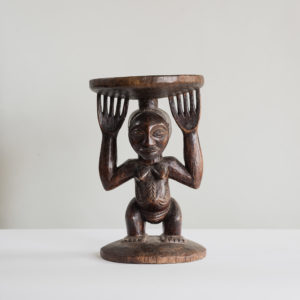
Luba stool
£375Luba stool
Luba art relates most commonly to the Kings and Chiefs of the Congolese Luba tribe, who would assert their power by display of ceremonial objects during ceremonies. Stools were considered to be the most important of these objects as they would serve not only as a seat but as a receptacle for the Chief’s spirit. The ruler is thus figuratively and literally supported by a caryatid figure - in this case a standing female ancestor. The carvings seen on her stomach allude to the maternal - such markings were common among many matrilineal societies in Africa to emphasise and protect the navel as the threshold between oneself, one’s mother and one’s own lineage.£375 -
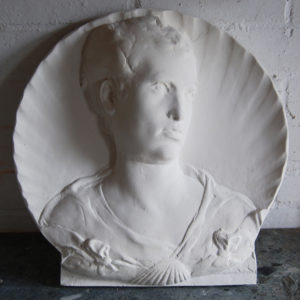
A relief cast plaster plaque of Andrea di Bono,
£360A relief cast plaster plaque of Andrea di Bono,
the portrait head carved in deep relief turning a sinestra, the young man depicted with cloaked shoulders and framed within a scallop shell,£360 -
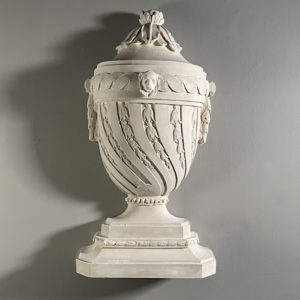
An English relief cast plaster lidded half-urn
£355An English relief cast plaster lidded half-urn
the vase-shaped body with wrythen flutes raised on a socle foot,£355 -
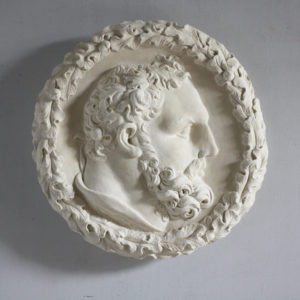
An English relief-cast plaster portrait plaque of Hercules
£350An English relief-cast plaster portrait plaque of Hercules
the roundel centred with a profile portrait of the Greek hero, within a leafy border£350 -
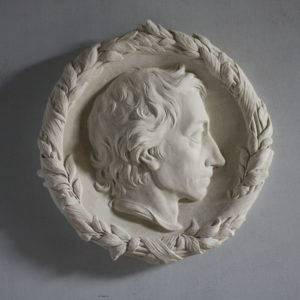
An English relief-cast plaster portrait plaque of Alexander Pope
£350An English relief-cast plaster portrait plaque of Alexander Pope
the roundel centred with a profile portrait of the poet, within a leafy border£350 -
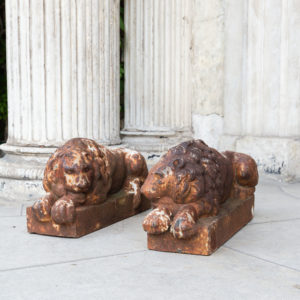
Pair of cast iron Canova lions
£350 the pairPair of cast iron Canova lions
the original sculpted by Antonio Canova in 1792 for the tomb of Pope Clement XIII in St. Peter's, Rome.£350 the pair -
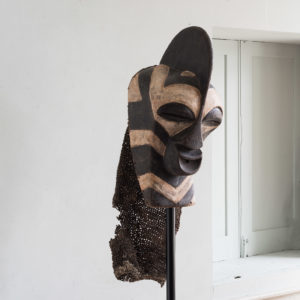
Songye Kilumwe Kifwebe mask (A)
£350Songye Kilumwe Kifwebe mask (A)
Very large Kifwebe mask with exaggerated sagittal crest. It is believed that the sagittal crest and conical protrusion contain the magical strength of the mask.£350 -
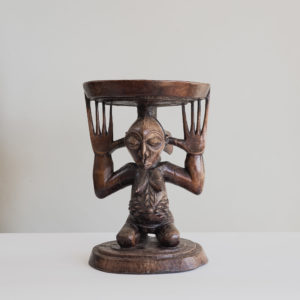
Luba stool,
£350Luba stool,
Luba art relates most commonly to the Kings and Chiefs of the Congolese Luba tribe, who would assert their power by display of ceremonial objects during ceremonies. Stools were considered to be the most important of these objects as they would serve not only as a seat but as a receptacle for the Chief’s spirit. The ruler is thus figuratively and literally supported by a caryatid figure - in this case a kneeling female ancestor with elongated and outstretched fingertips. The deep carvings seen on her stomach allude to the maternal - such markings were common among many matrilineal societies in Africa to emphasise and protect the navel as the threshold between oneself, one’s mother and one’s own lineage.£350 -
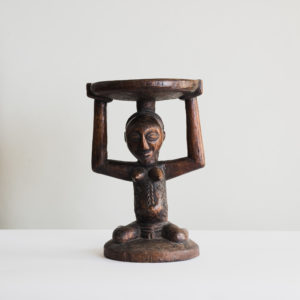
Tabwa stool
£350Tabwa stool
Congolese Tabwa art has distinct similarities to that of the Luba tribe, and its stools are used also in ceremonies by the Kings and Chiefs of the community with a means of establishing power and authority. The key difference seen between the two is the Tabwa’s traditional depiction of braided hair as a carved extension of the head and checkerboard-style scarification of the woman’s body.£350 -
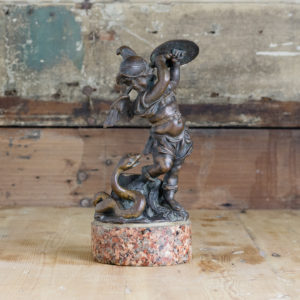
Nineteenth century bronze of the Heroic Putti,
£350Nineteenth century bronze of the Heroic Putti,
modelled holding shield and sword aloft on circular Aswan marble plinth base, possibly German, after the originals from the Mariensäule column in Munich by Ferdinand Murmann.£350 -
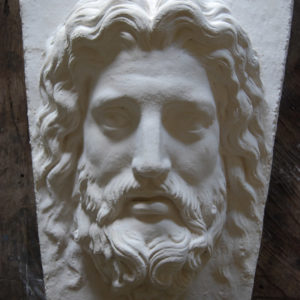
An English relief cast plaster Asclepius keystone
£350An English relief cast plaster Asclepius keystone
the bearded mask modelled on the tapered keystone,£350 -
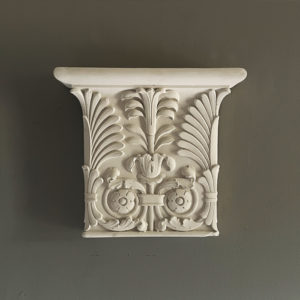
A relief-cast plaster pilaster capital
£345A relief-cast plaster pilaster capital
the capital with palmette clasps to the corners flanking a central stylised palm emanating from a pair of foliate scrolls below,£345 -
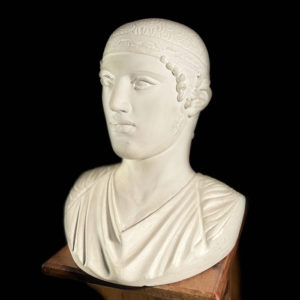
A plaster bust of Heniokhos – or The Delphic Charioteer
£325A plaster bust of Heniokhos – or The Delphic Charioteer
the young charioteer with a serene countenance,£325 -
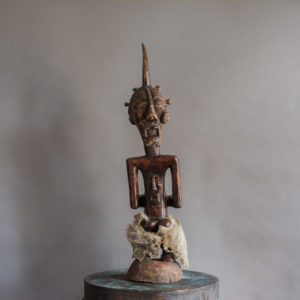
Songye Janus standing power figure,
£325Songye Janus standing power figure,
Congolese double-faced maternal power figure, adorned with animal hide and cowrie shells. The Songye power figure serves to protect its community from evil spirits.£325 -
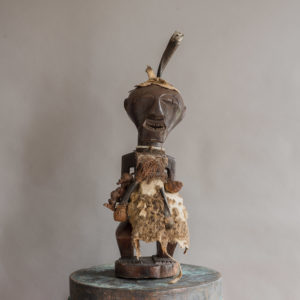
Songye standing male power figure,
£325Songye standing male power figure,
Standing male power figure from the Congolese Songye tribe, beautifully adorned with natural fibres, animal hide, and miniature power figure. These wooden power figures would have served to protect the Songye community from evil spirits and practitioners.£325 -
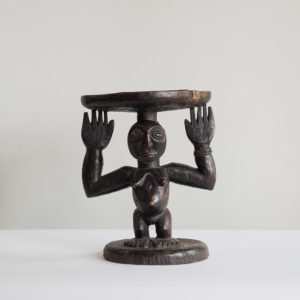
Luba stool
£325Luba stool
Luba art relates most commonly to the Kings and Chiefs of the Congolese Luba tribe, who would assert their power by display of ceremonial objects during ceremonies. Stools were considered to be the most important of these objects as they would serve not only as a seat but as a receptacle for the Chief’s spirit. The ruler is thus figuratively and literally supported by a caryatid figure - in this case a posed female ancestor with a carved headdress and jewellery.£325 -
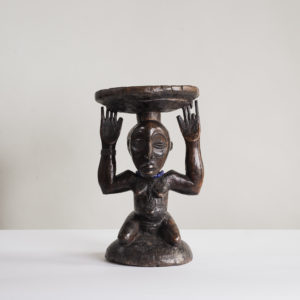
Luba stool
£325Luba stool
Luba art relates most commonly to the Kings and Chiefs of the Congolese Luba tribe, who would assert their power by display of ceremonial objects during ceremonies. Stools were considered to be the most important of these objects as they would serve not only as a seat but as a receptacle for the Chief’s spirit. The ruler is thus figuratively and literally supported by a caryatid figure - in this case a kneeling female ancestor adorned with beaded and carved jewellery. The deep carvings seen on her stomach allude to the maternal - such markings were common among many matrilineal societies in Africa to emphasise and protect the navel as the threshold between oneself, one’s mother and one’s own lineage. Damage to left hand.£325 -
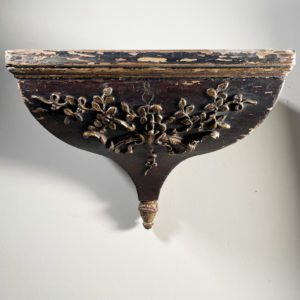
A Spanish wall-mounted bracket plinth
£320A Spanish wall-mounted bracket plinth
the rectangular wooden plinth, the underside relief-carved with foliate ornament£320 -
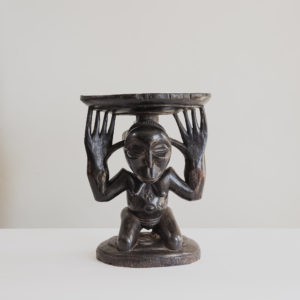
Luba stool,
£300Luba stool,
Luba art relates most commonly to the Kings and Chiefs of the Congolese Luba tribe, who would assert their power by display of ceremonial objects during ceremonies. Stools were considered to be the most important of these objects as they would serve not only as a seat but as a receptacle for the Chief’s spirit. The ruler is thus figuratively and literally supported by a caryatid figure - in this case a kneeling female ancestor with elongated and outstretched fingertips. The deep and patterned carvings seen on her stomach allude to the maternal - such markings were common among many matrilineal societies in Africa to emphasise and protect the navel as the threshold between oneself, one’s mother and one’s own lineage.£300 -
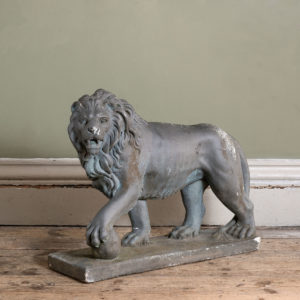
Composition stone Medici lion,
£280 -

Songye Luba mask (A)
£280Songye Luba mask (A)
The people of Songye are mainly known as a farming community, however they also take part in hunting and trading with other neighbouring communities. The distinct Songye style is easily recognisable in the Kifwebe mask by the mass of closely carved lines and bold shapes such as the protruding sagittal crest and X carved mouth. The intertwining of the red, black, and white colouring in these masks are said to symbolise the struggle between good (white) and evil (black and red) - the combination of these colours embodying the positive and dangerous force held within the mask. The ruggedness of the Kifwebe mask and its long raffia beard are said to symbolise the underworld and the spirits that escape from it. Further, it is believed that the sagittal crest and conical protrusion contain the magical strength of the mask.£280 -
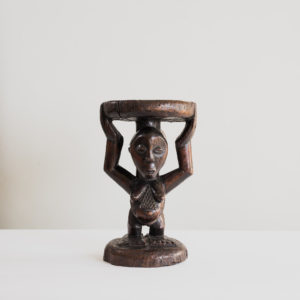
Luba stool
£275Luba stool
Luba art relates most commonly to the Kings and Chiefs of the Congolese Luba tribe, who would assert their power by display of ceremonial objects during ceremonies. Stools were considered to be the most important of these objects as they would serve not only as a seat but as a receptacle for the Chief’s spirit. The ruler is thus figuratively and literally supported by a caryatid figure - in this case a posed female ancestor with a carved headdress. The deep and patterned carvings seen on her stomach allude to the maternal - such markings were common among many matrilineal societies in Africa to emphasise and protect the navel as the threshold between oneself, one’s mother and one’s own lineage. The act of scarification will have often been used as a rite of passage, in order to symbolise a readiness for the pain of childbirth.£275 -
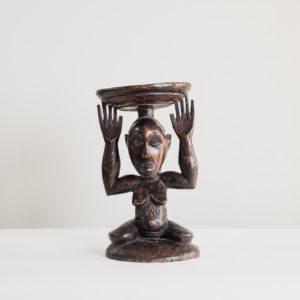
Tabwa stool
£275Tabwa stool
Congolese Tabwa art has distinct similarities to that of the Luba tribe, and its stools are used also in ceremonies by the Kings and Chiefs of the community with a means of establishing power and authority. The key difference seen between the two is the Tabwa’s traditional depiction of braided hair as a carved extension of the head and checkerboard-style scarification of the woman’s body. Such markings were common among many matrilineal societies in Africa to emphasise and protect the navel as the threshold between oneself, one’s mother and one’s own lineage.£275 -
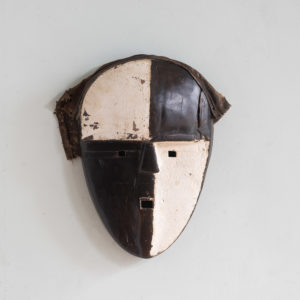
Kusu Nsembu mask
£250Kusu Nsembu mask
The Nsembu mask was used exclusively by members of the Nkunda Secret Society for the purposes of adult initiation and divination; the mask representing the diviners spirit. The chequered pattern may represent the interaction of opposites - day and night, man and woman, good and evil - within ones spiritual journey. It is also reminiscent of certain scarification practices. The Kusu people inhabit the Ituri rainforests, located in the northeastern part of the Congo.£250 -
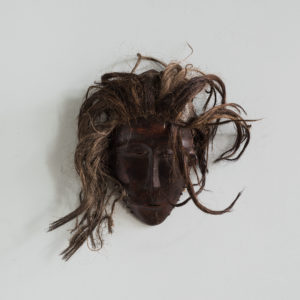
Tchokwe Pwo mask,
£245Tchokwe Pwo mask,
The Pwo is a classic Chokwe mask genre that honours their founding female ancestries as guardians of fertility and procreation. Chokwe masks were made and worn by men, often performed during the celebrations that mark a completion of initiation into adulthood and with means to honour women who had survived the difficulty of childbirth.£245 -
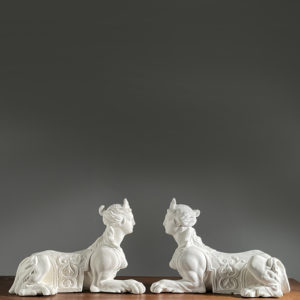
A pair of plaster Sphinx, cast in relief
£240 -
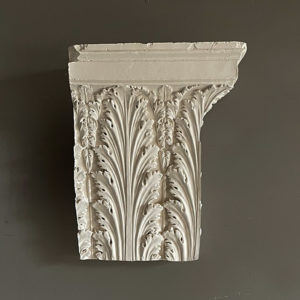
An English cast plaster Corinthian order pilaster capital,
£220An English cast plaster Corinthian order pilaster capital,
the half capital, intended for heading an "attached column", cast over-all with formalised stiff-leaf acanthine ornament spreading to a rectangular capping plinth, cast with wire hoops to the reverse for wall-hanging if preferred,£220 -
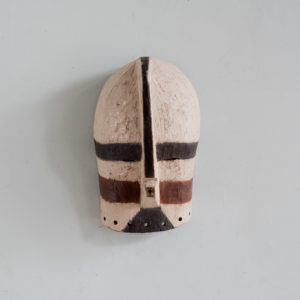
Songye Luba mask (B)
£200Songye Luba mask (B)
The people of Songye are mainly known as a farming community, however they also take part in hunting and trading with other neighbouring communities. The distinct Songye style is easily recognisable in the Kifwebe mask by the mass of closely carved lines and bold shapes such as the protruding sagittal crest and X carved mouth. The intertwining of the red, black, and white colours in these masks are said to symbolise the struggle between good (white) and evil (black and red) - the combination of these colours embodying the positive and dangerous force held within the mask. Further, it is believed that the sagittal crest and conical protrusion contain the magical strength of the mask.£200 -
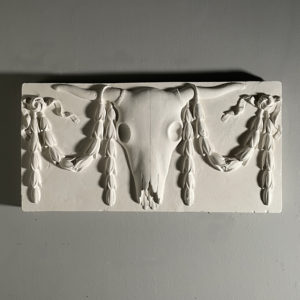
An English plaster relief-cast frieze
£195An English plaster relief-cast frieze
the frieze centred with a long-horned bucranium flanked by ribbon-tied bell-flower swags and pendants,£195 -
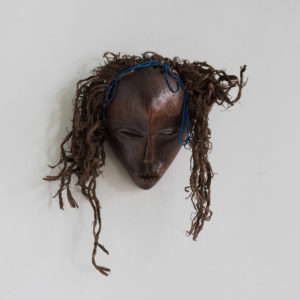
Tchokwe Pwo mask,
£195Tchokwe Pwo mask,
The Pwo is a classic Chokwe mask genre that honours their founding female ancestries as guardians of fertility and procreation. Chokwe masks were made and worn by men, often performed during the celebrations that mark a completion of initiation into adulthood and with means to honour women who had survived the difficulty of childbirth. Adorned with typical scarification designs to the face, with braided natural fibres alongside draped blue beads.£195 -
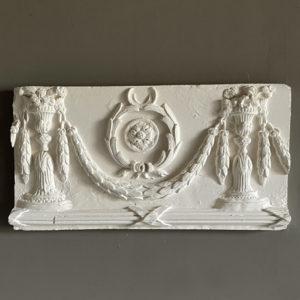
An English plaster section of frieze
£185An English plaster section of frieze
the frieze comprising fruit-filled campagna urns linked by a laurel swag with a foliate wreath above and ribbon-tied reeds below,£185 -
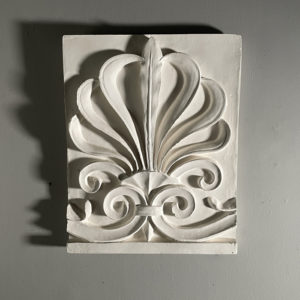
A plaster cast of an anthemion in relief
£185A plaster cast of an anthemion in relief
the rectangular plaque cast in relief with a striking anthemion motif£185 -
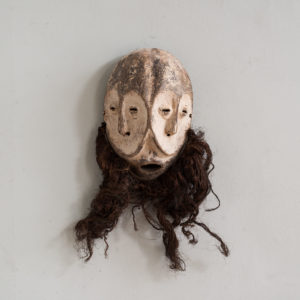
Lega Idimu mask (E)
£180Lega Idimu mask (E)
Similarly to the pipibudze masks of the Kwele tribe, the Lega’s Lukwakongo (miniature) masks have a heart-shaped face framed by a line formed by the nose, the eye rows and the planes of the cheeks. The wooden face is whitened and smoothed with kaolin clay, which is said to allude to the refined and perfected nature of the Bwami initiate, some of whom use the masks during initiation ceremonies. This mask would rarely be worn on the front of the face, but instead on the side of the face, the forehead, tied to the body, displayed on the fences, or dragged across the floor during Bwami meetings and ceremonies. The two faces share a mouth and a beard.£180 -
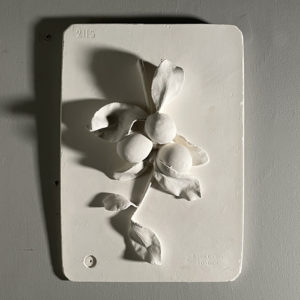
A cast plaster relief of clustered plums
£180A cast plaster relief of clustered plums
after an original cast by Brucciani and Co. and bearing their stamp,£180 -
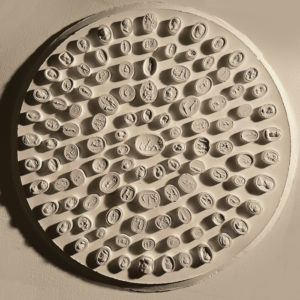
A large English plaster roundel relief plaque,
£175A large English plaster roundel relief plaque,
the raised ovals and roundels variously depicting various minatures of classical allegory and portrait,£175 -
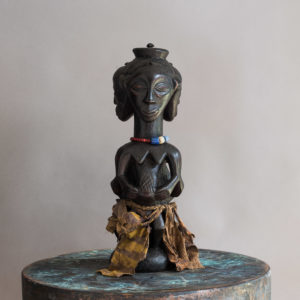
Luba-Hemba triple figural group,
£175Luba-Hemba triple figural group,
Triple maternal power figure with draped cloth fibres and checkered scarification to the belly and head. These wooden power figures would have served to protect the Songye community from evil spirits and practitioners.£175 -
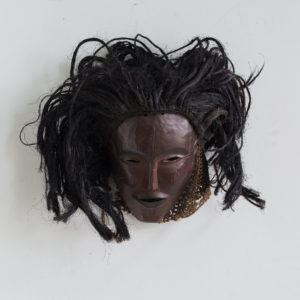
Tchokwe Pwo mask,
£175Tchokwe Pwo mask,
The Pwo is a classic Chokwe mask genre that honours their founding female ancestries as guardians of fertility and procreation. Chokwe masks were made and worn by men, often performed during the celebrations that mark a completion of initiation into adulthood and with means to honour women who had survived the difficulty of childbirth. Minimal scarification design to face and woven natural fibre covering.£175 -
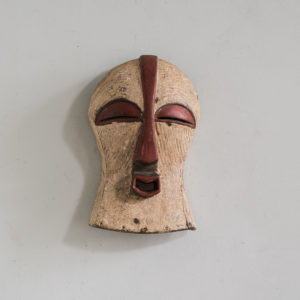
Luba Bilume Kifwebe mask (A)
£175Luba Bilume Kifwebe mask (A)
The people of Songye are mainly known as a farming community, however they also take part in hunting and trading with other neighbouring communities. The distinct Songye style is easily recognisable in the Kifwebe mask by the mass of closely carved lines and bold shapes such as the protruding sagittal crest and X carved mouth. The intertwining of the red, black, and white colouring in these masks are said to symbolise the struggle between good (white) and evil (black and red) - the combination of these colours embodying the positive and dangerous force held within the mask. Further, it is believed that the sagittal crest and conical protrusion contain the magical strength of the mask.£175
Featured Items
-
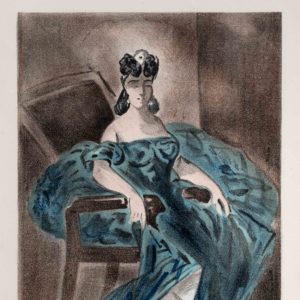
Portraits Part I by Constantin Guys, Verve Vol 2 / No. 5-6.
£500Portraits Part I by Constantin Guys, Verve Vol 2 / No. 5-6.
The Verve Review was a purposefully luxurious. It ran from 1937 to 1960, but with only 38 editions available, due to the high degree of design and editorial work dedicated to each issue. Each edition contained unique lithographic prints, commissioned by the editor, and each cover a double-page lithograph elaborated by one of the artists contained within. It was the brainchild of its editor Stratis Eleftheriades, a Greek National who moved to Paris in the early thirties to take part in the growing Modernist movement, writing under the name of Teriade.£500 -
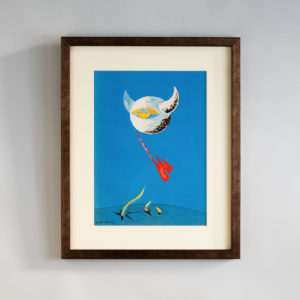
The Moon by André Masson, Verve Vol. 1 / No. 2.
£600The Moon by André Masson, Verve Vol. 1 / No. 2.
The Verve Review was a purposefully luxurious. It ran from 1937 to 1960, but with only 38 editions available, due to the high degree of design and editorial work dedicated to each issue. Each edition contained unique lithographic prints, commissioned by the editor, and each cover a double-page lithograph elaborated by one of the artists contained within. It was the brainchild of its editor Stratis Eleftheriades, a Greek National who moved to Paris in the early thirties to take part in the growing Modernist movement, writing under the name of Teriade.£600 -
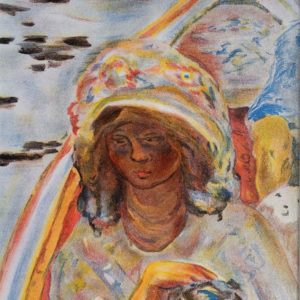
Portrait Fragment by Pierre Bonnard, Verve Vol 2 / No. 5-6.
£600Portrait Fragment by Pierre Bonnard, Verve Vol 2 / No. 5-6.
The Verve Review was a purposefully luxurious. It ran from 1937 to 1960, but with only 38 editions available, due to the high degree of design and editorial work dedicated to each issue. Each edition contained unique lithographic prints, commissioned by the editor, and each cover a double-page lithograph elaborated by one of the artists contained within. It was the brainchild of its editor Stratis Eleftheriades, a Greek National who moved to Paris in the early thirties to take part in the growing Modernist movement, writing under the name of Teriade.£600 -
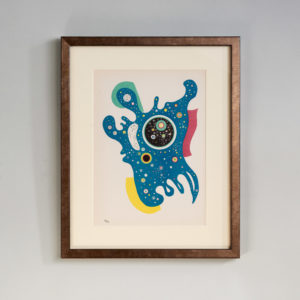
Stars by Wassily Kandinsky, Verve Vol. 1 / No. 2.
£800Stars by Wassily Kandinsky, Verve Vol. 1 / No. 2.
The Verve Review was a purposefully luxurious. It ran from 1937 to 1960, but with only 38 editions available, due to the high degree of design and editorial work dedicated to each issue. Each edition contained unique lithographic prints, commissioned by the editor, and each cover a double-page lithograph elaborated by one of the artists contained within. It was the brainchild of its editor Stratis Eleftheriades, a Greek National who moved to Paris in the early thirties to take part in the growing Modernist movement, writing under the name of Teriade.£800

